Canadian Historic Sites: Occasional Papers in Archaeology and History No. 15
Report of the 1972 Archaeological Excavations of the Market Shoal Tower, Kingston, Ontario
by Donald A. Harris
Artifacts
The artifact collection from the tower was small and consisted mostly
of iron building hardware. The ceramics, glass and miscellaneous groups
of material were very poorly represented. The building hardware in the
course of time had fallen into the debris as the doors, window mouldings
and other wooden features had rotted and pulled away from the stone
wall. The other large category of metal artifacts found was ordinance
that had been left behind when the tower was abandoned. Because the
tower stood open to the public and the weather, and because of the
undifferentiated stratigraphy, artifact counts were not considered
pertinent. This was especially true of nails, and no systematic effort
was made to collect all of the nails in the building. To have done so
would have destroyed other important features such as the remaining
flooring and the aperture mouldings. A sample of the different types of
nails used was taken, however. Although object counts were made, it had
been the author's intention to treat these artifacts in a qualitative
rather than a quantitative manner as a result of the feeling that the
sample was not large enough or representative enough to justify
statistical treatment.
Ceramics
The ceramic collection represented 11 vessels and none of these were
very distinctive. All could be dated to the latter part of the 19th
century or the early 20th century and they consisted of the
following:
| Porcelain egg cups | 2 |
| Stoneware beer bottle with the inscription "Fisher and Thorton,
Kingston", near base | 1 |
| Plain, widemouth, partially vitrified storage jar |
1 |
| Plain, partially vitrified cup with wheat straw motif moulded on
rim | 1 |
| Plain saucer same as cup | 1 |
| Plain, partially vitrified saucer, no motif | 1 |
| Small bowl, plain, partially vitrified | 1 |
| Small plate, white earthenware paste, no decoration | 1 |
| Black transfer printed cup | 1 |
| Tea pot lid with treacle glaze common to many New England
potteries, e.g., Bennington | 1 |
| Small porcelain, Siamese cat figurine | 1 |
| Miniature plate, cup and saucer of porcelain from child's tea
set | 3 |
Because of the small size of the collection it would be difficult to
say that it represented garrison life. What was more likely was that it
represented the people who lived in the tower after the garrison was
removed and the tower abandoned by the military forces.
Pipes
The pipe fragments from the Market Shoal tower included only 12 stem
fragments and one pipe bowl. Of the pieces that had identifiable marks
all could be dated to the mid-19th century. Only three pipestem
fragments carried any indication of maker's marks and two of these were
the mark of William Murray, Glasgow. Murray was known to have been
making pipes in that city between the years 1833 and 1861 (Walker
1971: 25). The other pipe stem was marked Dixon. representing a pipe
manufacturer in Montreal between the years 1847 and 1894 (Walker
1971: 25). Three of the stems had traces of green or yellow glaze around
the mouthpieces, a practice which was popular during the 19th century,
and another had a flattened tip or mouthpiece (Fig. 41). This effect
was quite similar to the type of tip used on briar pipes which had
become popular during the latter part of the 19th century (Walker 1971:
31). The only bowl found had its distinguishing characteristics marred
and was unable to provide any clues as to its place or date of
origin.
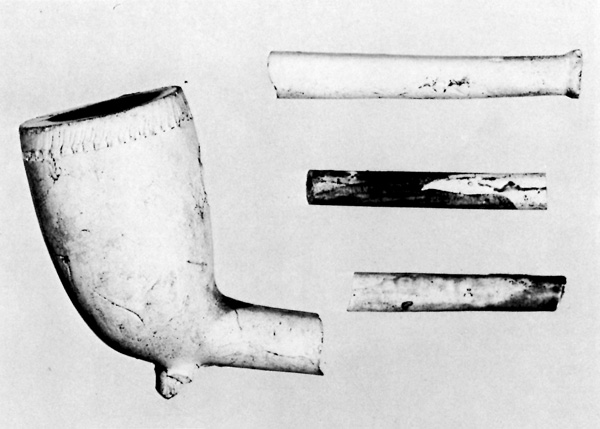
41 Clay pipe fragments excavated from the Shoal tower.
|
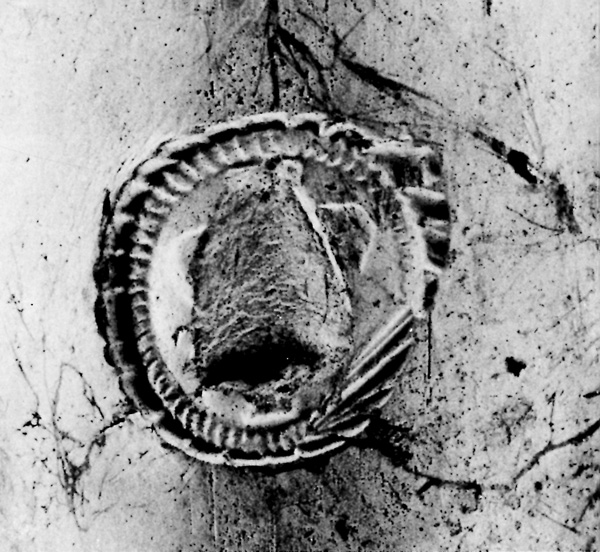
42 Married maker's mark on the side of the pipe bowl.
|
Coins
Only two coins were found, one a copper halfpenny and the other a
copper penny (Figs. 43 and 44). Both were minted by the Bank of Upper
Canada in 1857. The Bank of Upper Canada was formed in Toronto in 1820
and in 1849 it became the government bank after the burning of the
Parliament buildings in Montreal. It was also given the privilege of
issuing copper coins, but during the financial crisis of 1867-68 its
operations were suspended and it was unable to reorganize (Breton
1894: 116).
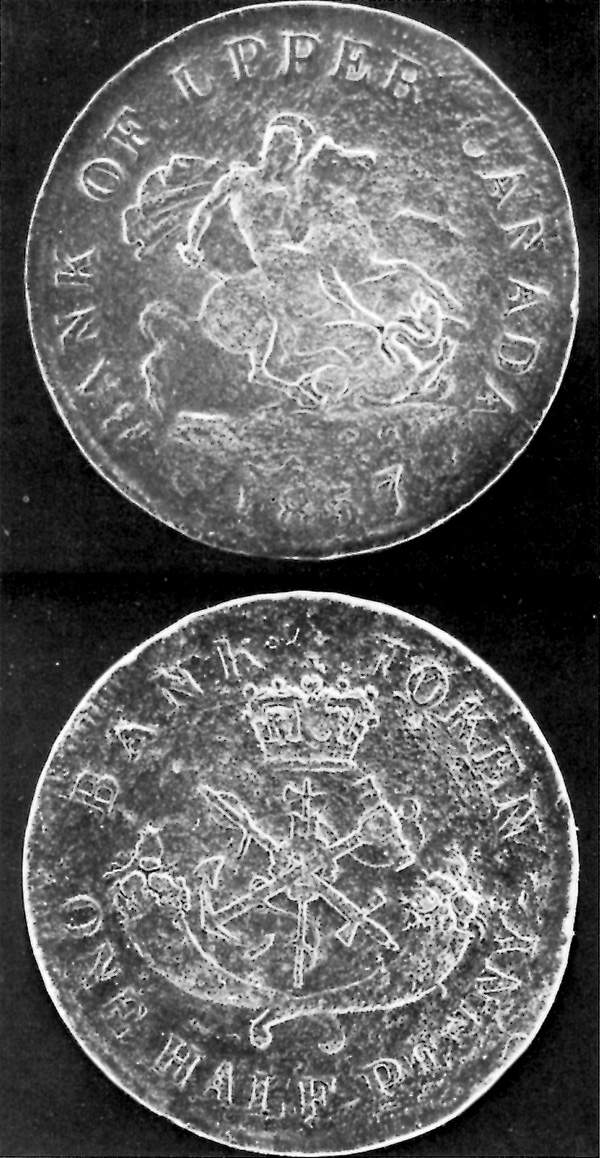
43 Obverse and reverse sides of 1857 Canadian halfpenny.
|
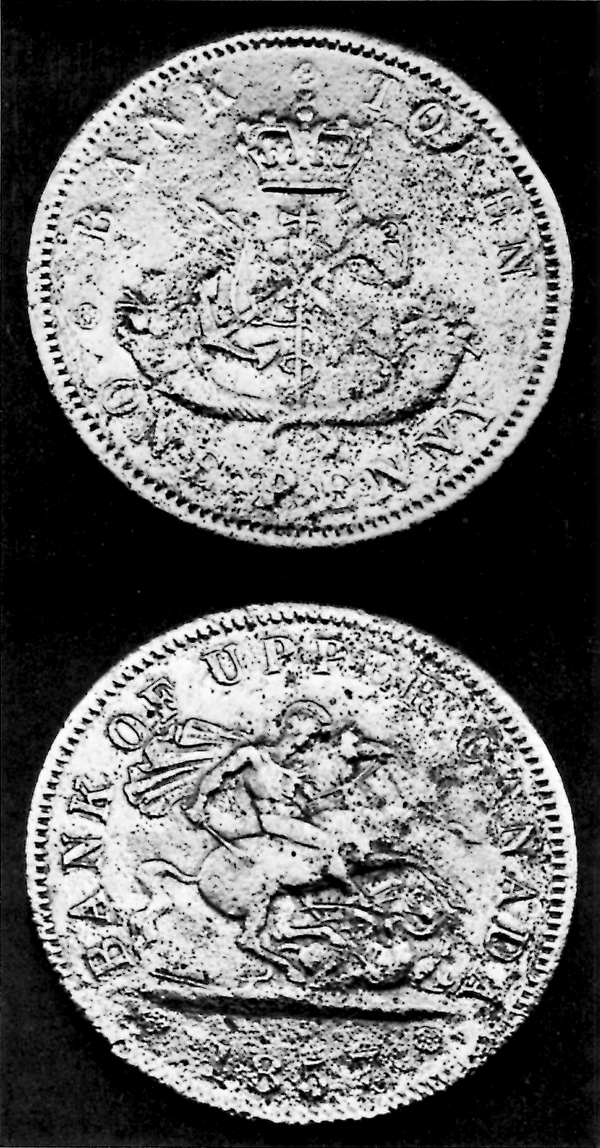
44 Obverse and reverse sides of 1857 Canadian penny.
|
Buttons
Only six buttons were found in the excavation. Five of these were white,
felspathic buttons of the type found on shirts (Fig. 45). The sixth was
a brass Canadian militia button (Fig. 47). Embossed on the face of this
button is a crown over three fieldpieces with the words "Canada
Militia" encircling the edge. On the reverse side of the button are
stamped the words "Superior Quality" and the letters "P P B". All parts
of the button including the face, back and eye are made of brass. The
face is domed and folded around the edge of the back and the eye is a
U-shaped loop riveted through the back of the button. This type of
button, described by Emilio (1911: 161), was worn by the Canadian Militia
Army Artillery between the years 1890 and 1896, but Emilio's description
varies from that of the button found in that he noted the maker as being
P. Tait Limerick. Associated with the buttons were two button sticks or
button cleaning guards (Fig. 46).
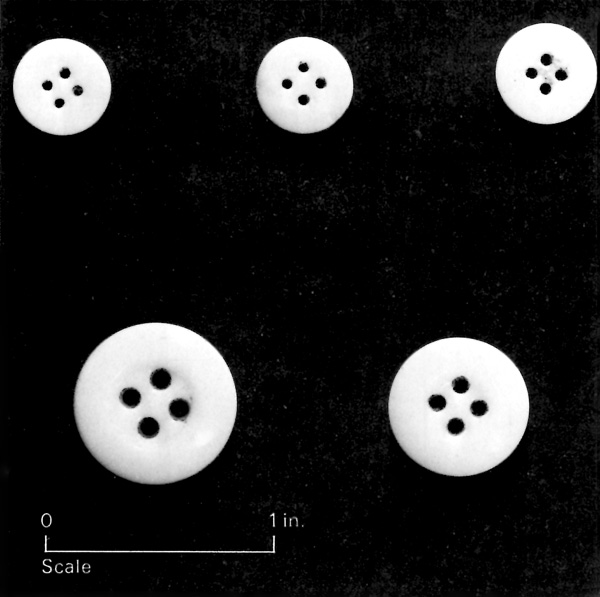
45 Five white feldspathic buttons.
|
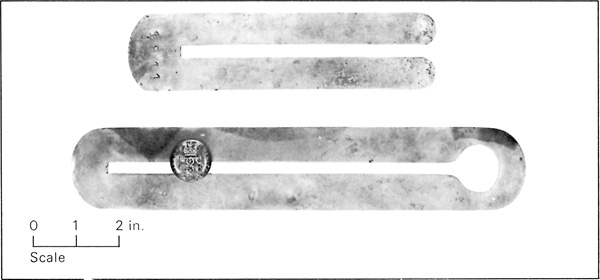
46 British military button "sticks" used as guards to prevent cleaning
agent from getting on uniforms.
|
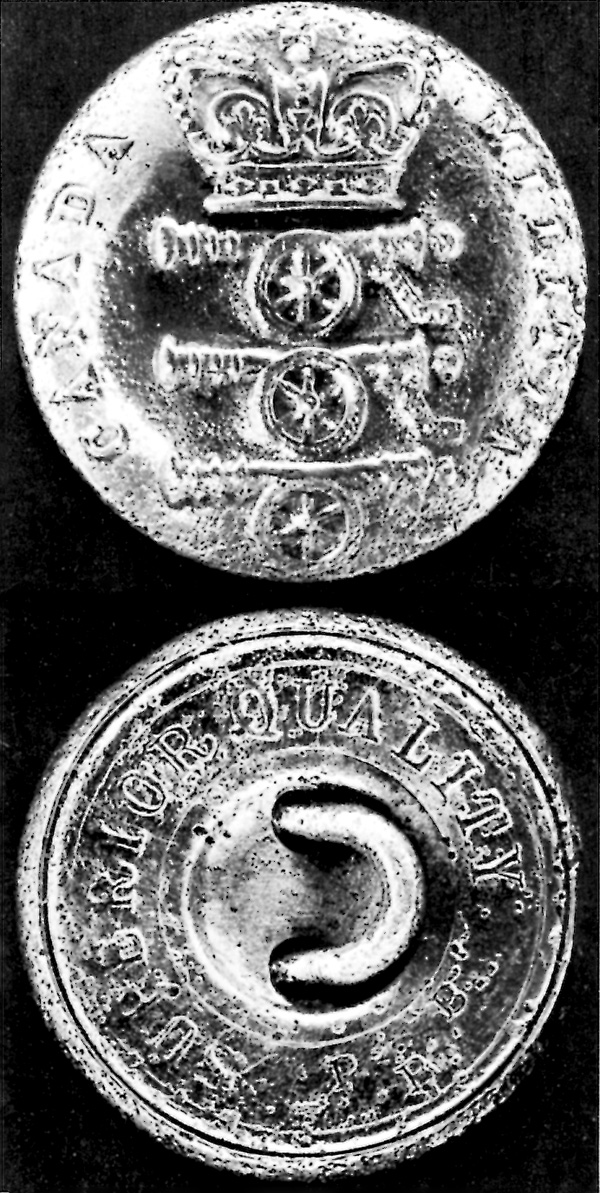
47 Reverse and observse sides of Canadian militia button used by the
militia during the mid-1890s.
|
These brass guards were slid between the tunic and the button to
protect the tunic while the button was being cleaned. Both of the sticks
are made of brass, but one is open-ended while the other is closed. On
one side of the open-ended button stick is stamped the date 1811 and the
other side bears the stamp of the manufacturers "Smith & Wright,
Button Ornament Manufacturers, Contractors, Birmingham." The closed end
button stick bears no manufacturer's stamp, just the stamped inscription
"J (broad arrow) II". Button sticks were discontinued with the recent
introduction of non-tarnish buttons.
Glass
The glass artifact collection was not much larger than that of the
ceramics, numbering 16 pieces. Of these 16, three were liquor
bottles, three were druggist's bottles, two were beverage bottles, three
were lighting devices and five were table glass. This object count was
based upon identifiable fragments and does not necessarily represent
whole objects.
Liquor Bottles
Of the three liquor bottles found, two were olive-green and had
been turn moulded and the other was made of a brown glass that carried
stippling and part of an embossed design. The two olive-green bottles
date from a post-1870 period (Toulouse 1969: 532). The brown stippled
bottle looks to have been machine made (Jones. pers. com.) and probably
dates from the 20th century.
Beverage Bottles
Two aquamarine beverage bottles were recovered from the
excavation, but one was very fragmented and all that could be determined
about it was that it had been made in a two-piece mould. The other (Fig.
48) was made for the American Bottling Company and used the Hutchison
stopper as a closure device. This stopper was patented in 1879 and
discontinued in 1912 (Riley 1958: 97-98).
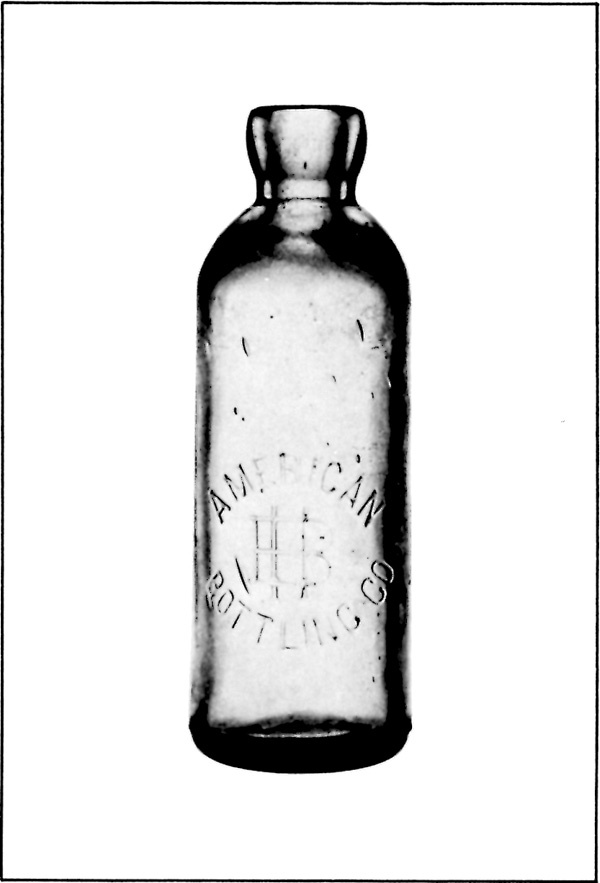
48 Beverage bottle of aquamarine glass employing Hutchinson stopper made
for American Bottling Company.
|
Druggist's Bottles
Three druggists bottles were recovered from the excavation. Two of
these (Fig. 49) were complete and the third was represented by the neck
and lip. All three of these bottles had the type of lip known as the
"Prescription Lip" which was illustrated in the 1897 annual catalogue of
Whitall, Tatum and Company (1897: 10). The two complete bottles were
made by this company for W. D. Gordon and Company, Chemists, located on
Princess Street, Kingston. This company appears in the Kingston City
directory for the year of 1872, but does not reappear in succeeding
years. One of these bottles was an 8-oz. "Philadelphia Oval" (Whitall,
Tatum and Company, 1897: 15) and the other was a tall "French Square" of
the same capacity (Whitall, Tatum and Company, 1897: 12). The Whitall,
Tatum and Company glass manufacturer, whose factories are located in
Millville, New Jersey, developed in 1857 out of a series of ownership
and partnership changes that began with James Lee in 1606. Beginning as
manufacturers of cylinder glass it is now the oldest continuous
glassmaking plant in the United States (Toulouse 1971: 544-45)
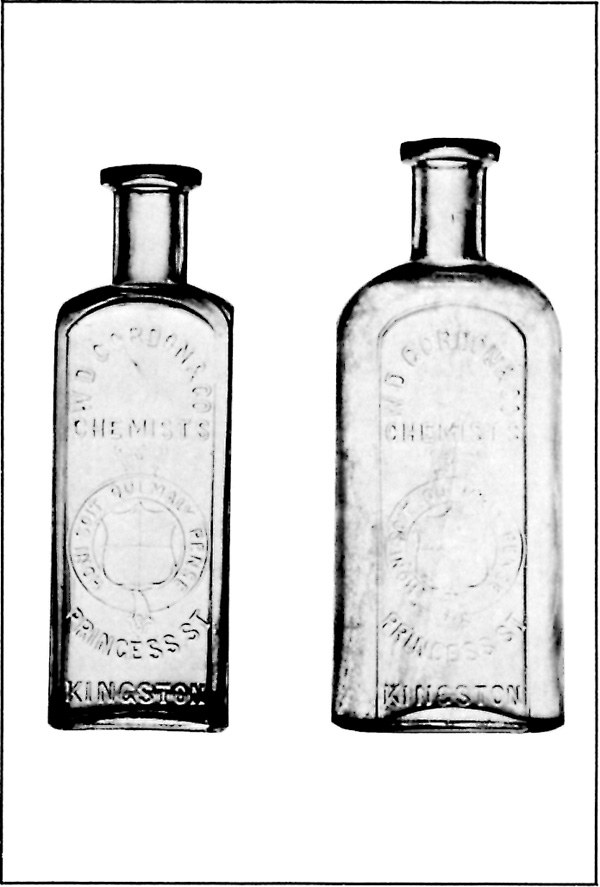
49 Two druggists bottles made by Whitall, Tatum and Company for W. D.
Gordon, chemist, Princess Street, Kingston. The bottle to the left is a
"French square" and that on the right is a "Philadelphia Oval," Both are
from the same provenience.
|
Lighting Devices
Lighting devices included a lamp chimney, a font for an oil lamp and
an oil lamp base with handle (Fig. 50). It was uncertain as to whether
or not these had come from the same lamp but it was quite possible. The
pressed glass lamp base was circular in shape and unadorned by any
decorative motif.
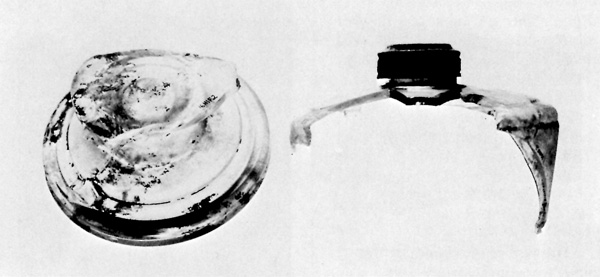
50 Font and base from an oil lamp. These came from the same provenience
and may be from the same lamp.
|
Table Glass
This category included five different patterned pieces, all of which
were pressed and date from the latter part of the 19th century. One such
pattern was that of the "Bull's Eye Variant" produced in the 1850s and
1870s. This particular piece (Fig. 51) was a goblet and closely fitted
the description given by Lee (1960: 154-55). The metal of the glass was
heavy and there were six bull's eyes tapering down into an hexagonal
stem, but the stem itself was missing as was the foot. The bull's eye
pattern was employed by the New England Glass Company and the Boston and
Sandwich Glass Company, and Lee (1960: 154-155) states that the variant
style was illustrated in an undated catalogue of Bryce Brothers of
Pittsburg, Pennsylvania. The second heavy patterned piece was a small
creamer with a flattened sawtooth design. This creamer closely resembled
one illustrated by Lee (1960: 202) and is shown in Figure 52. This
pattern was also produced from the late 1840s and early 1850s and was
illustrated in an undated catalogue of George Duncan and Sons of
Pittsburg, Pennsylvania (Lee 1960: 138)

51 Goblet of pressed glass with "Bulls Eye Variant" design.
|
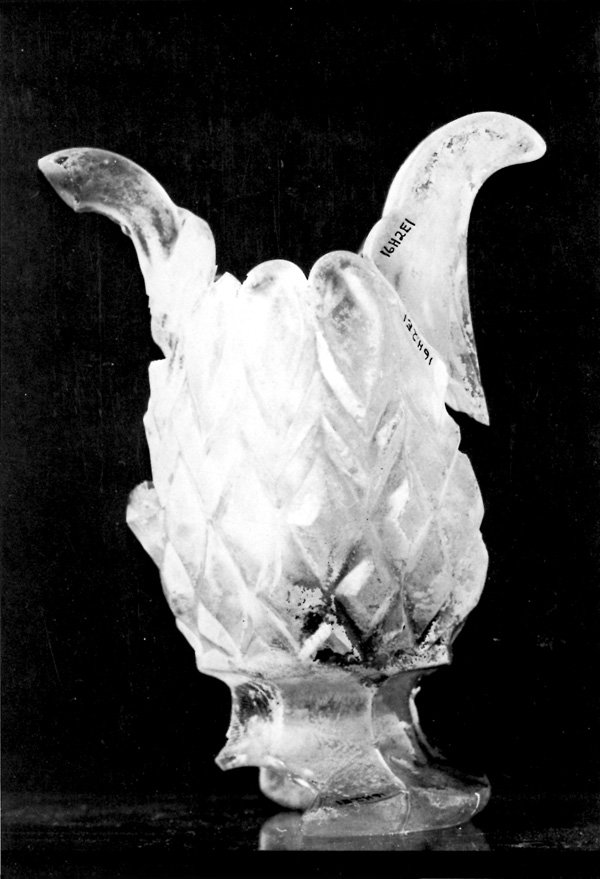
52 Small compressed glass creamer with flattened saw-soothed design.
|
The last glass object of the heavy pressed variety was a small bowl
with ribbed sides. This bowl had what appeared to be a ground and
polished pontil mark on the base and has not yet been identified (Fig.
53). There were two other pressed glass pieces in the collection, but
these were much lighter in weight than the aforementioned vessels. The
first of these was represented by a small rim fragment that carried a
section of a decorative motif on the interior surface. This was probably
a lid to a sugar dish (Fig. 54) and the decorative motif was that of the
"Cabbage Rose" (Lee 1960: 373-4). This pattern was popular in the late
1860s, one producer being the Central Glass Company in Wheeling, West
Virginia. Another vessel of light weight in pressed glass was a small
honey or preserve dish measuring 3-1/2 inches in diameter (Fig. 55).
This dish bore the "Bleeding Heart" pattern produced by the King Glass
Company of Pittsburg prior to its absorption into the United States
Glass Company in 1891. The series bearing this motif was begun in the
1870s (Lee 1960: 399-400). All of these fragments were tested under
ultraviolet light and found to contain no lead, indicating that they
were made after 1864 when soda glass began to replace lead glass
(McKearin & McKearin 1948:142).
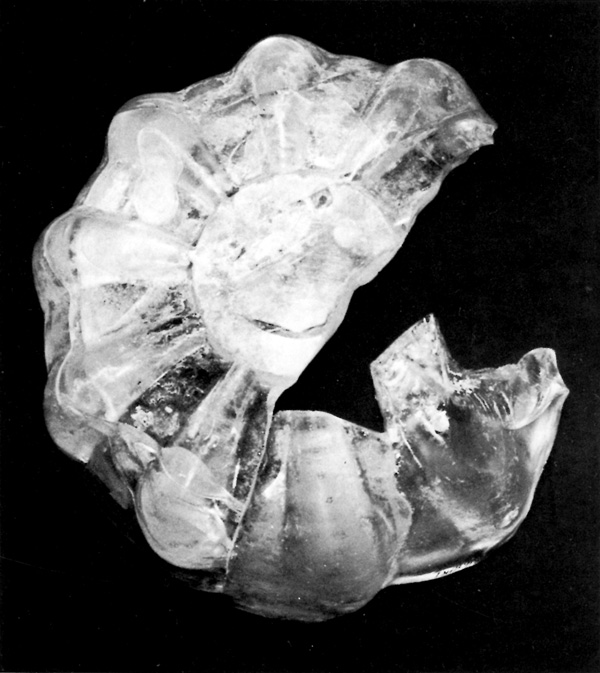
53 Pressed glass tumbler with ground and poished pontil mark on the
base.
|
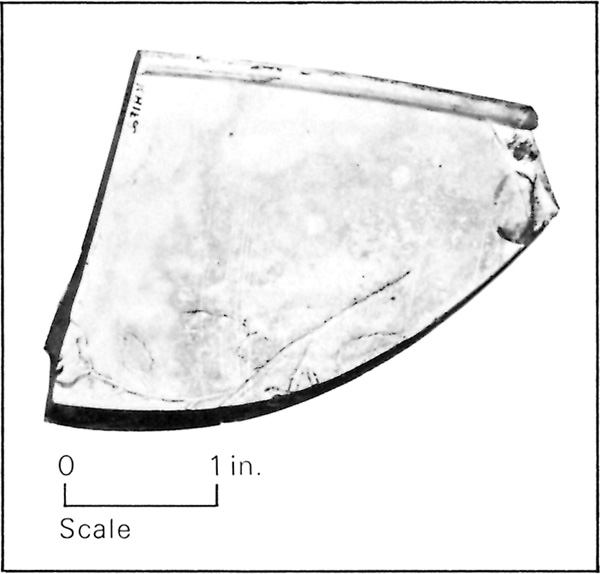
54 Pressed glass sugar bowl lid with "Cabbage Rose" design.
|
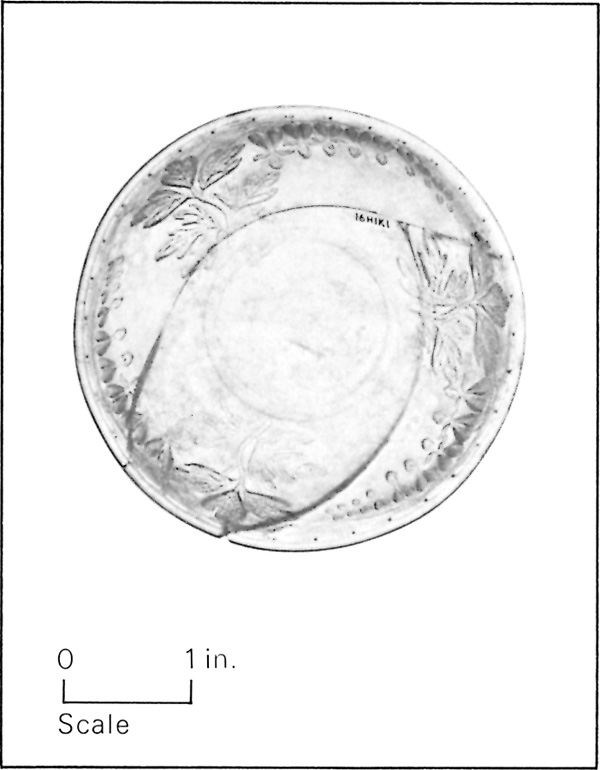
55 Small pressed glass honey or preserve dish with a "Bleeding Heart"
design.
|
Window Glass
The remaining glass that was found within the tower was that which
had been used to glaze the windows of the magazine. This plate glass was
found on the window sills and had a thickness of 15/64 in. It is not
known where this glass was manufactured, but it was probably cast (Davis
1949: 168-70).
Metal Artifacts
The metal artifacts found constituted the bulk of the artifacts
retrieved from the excavation and most of these items were building
hardware in the form of nails and wall anchors. Metal artifacts were
divided into functional groups; building hardware, ordnance, ordnance
hardware, artillery tools and miscellaneous.
Building Hardware
Some mention of the manner and materials with which the tower was
constructed have already been made. The major building materials used
were limestone and brick. The floors were wooden and the flooring was
held in place with wrought nails. These nails (Fig. 56) were for the
most part 4 in. or 6 in. in length with a chisel tip and a
diamond-shaped head. There were also 5, 4-1/2, 3-3/4 and 3 in. wrought
nails used as well. Some cut nails in lengths of 6, 5, 4 and 3-1/4 in.
were found. The only use noted for these cut nails was in the
construction of the wooden window and door mouldings. There were also
some wire nails found, but their number was very small and probably did
not relate to the original tower construction. Another type of nail
found in the construction of the tower was a copper tack 13/16 in. in
length. These tacks were used to attach the copper sheathing to the door
and window frames of the magazine.
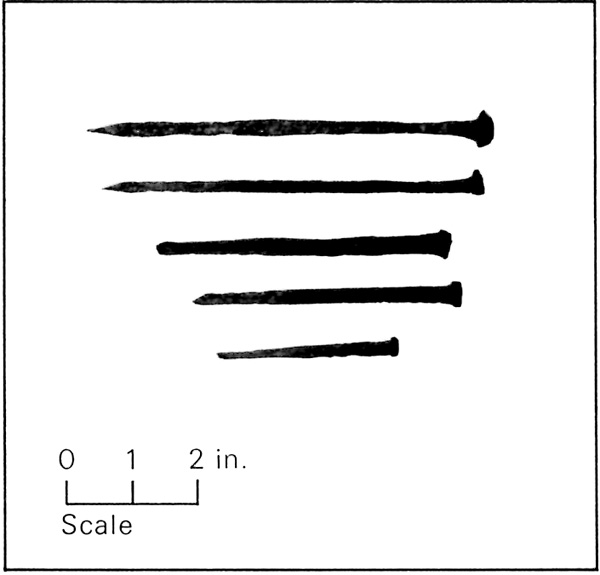
56 Various sizes of nails used in the woodwork of the tower.
|
Among the debris a large number of washer-headed bolts were found
still retaining wood about their shanks. These bolts measured
approximately 6 in. in length and had a shank diameter of 7/16 in.
Although none of these bolts were found in situ their most
probable use was that of binding together the laminated interior doors
of the structure. The gap between the washered head and the nut on the
threaded end averaged 4-5/8 in. although this measurement varied
somewhat. An example of this type of bolt can be seen in Figure 57.
Along with these bolts a number of threaded screws were found. These
screws were used to attach the iron floor battens to the flooring or to
attach closure hardware such as shutter fasteners to their mouldings.
All of those measured were 2 in. long.
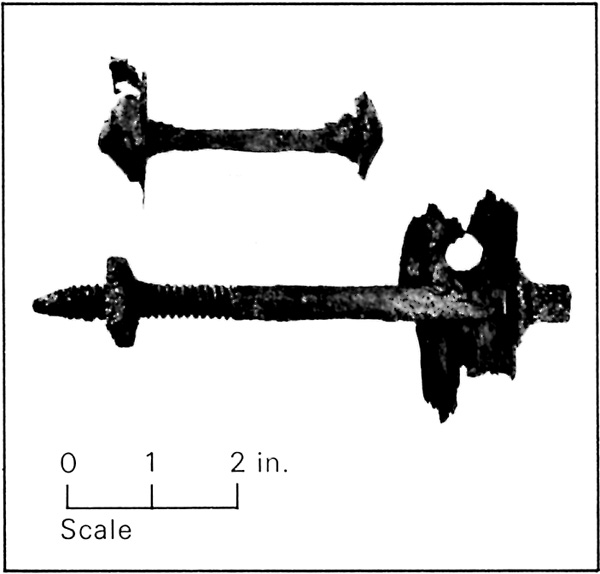
57 The bolt at the top has been described as a batteau bolt while that
at the bottom was used to bind together the laminated wooden doors that
were used in the interior passageways of the tower.
|
Found in large quantities and still in situ were wrought iron
wall anchors. These wall anchors (Fig. 58) were approximately 7 in. in
length and were used to retain uniform racks in position along the
walls. Contrary to the statement made by Lavell concerning the use of
non-ferrous metals in the magazine, these anchors were used to retain
wall racks in that room.
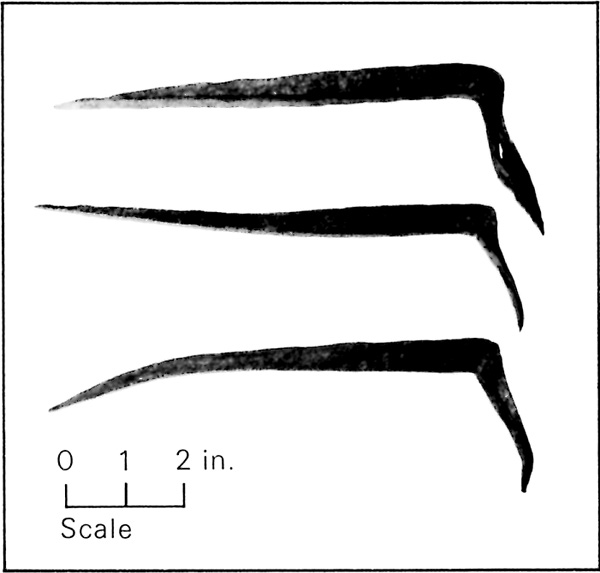
58 Wrought iron wall anchors used throughout the building to fasten
equipment and uniform hangers to the brick walls of the tower.
|
Another item already discussed but used throughout the tower were iron
straps to batten down the flooring. This batten shown in Figures 7 and
62 was made especially for this tower as demonstrated in the fitting of
the various corners and angles of the building. Much of this material
remained in situ and was left there. A number of small door
covering vents were found still in place within the tower and an example
of these is shown in Figure 63. This particular door had fallen or been
removed from its hinges and was found in the debris of the commissariat
stores.
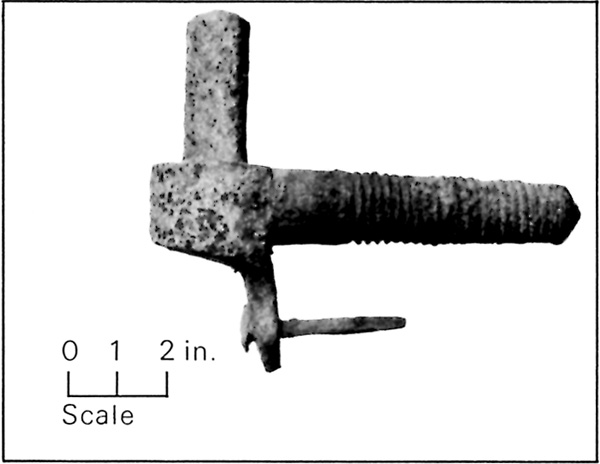
59 Pintle used on the first set of wooden doors just inside the main
entranceway of the tower. The outside doors to the tower were sheet iron
and their pintles were fixed in the mortar of the building.
|
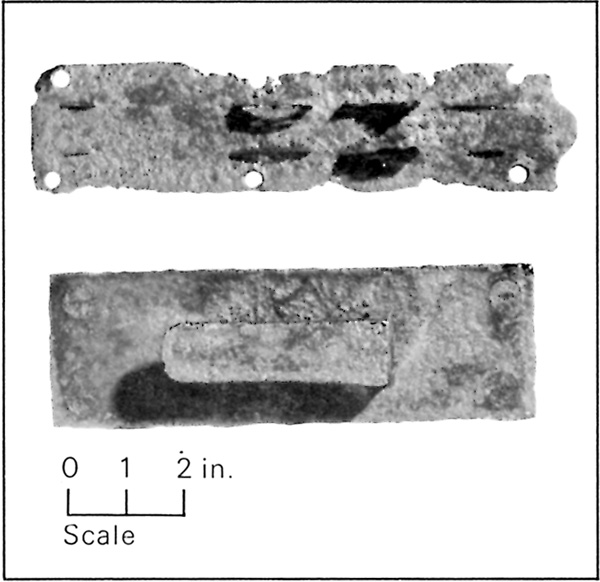
60 Wooden bolt receiver on left and door latch part on right.
|
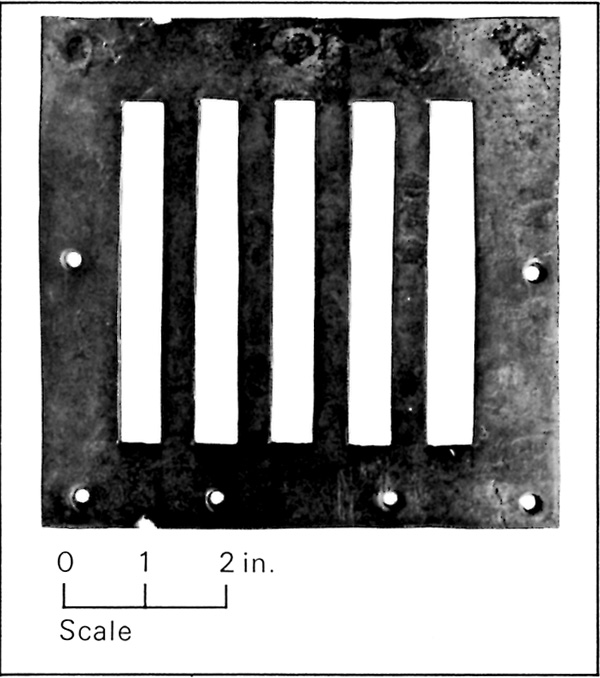
61 Copper grate of uncertain use and provenience.
|
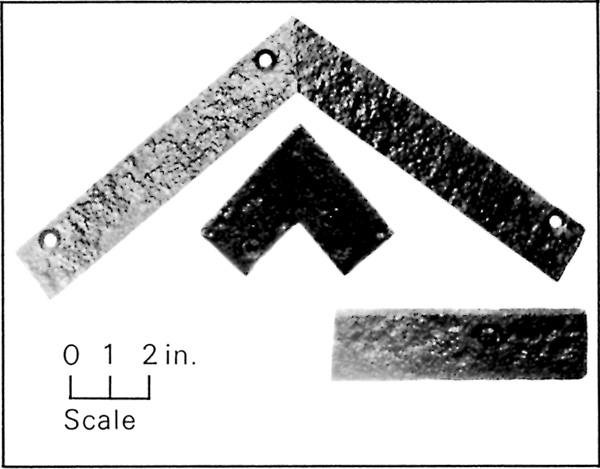
62 Sections of iron floor batten. The top two were cast to fit into the
corners of the commissariat while the third piece is just a short piece
of straight stock. All are from the same provenience.
|
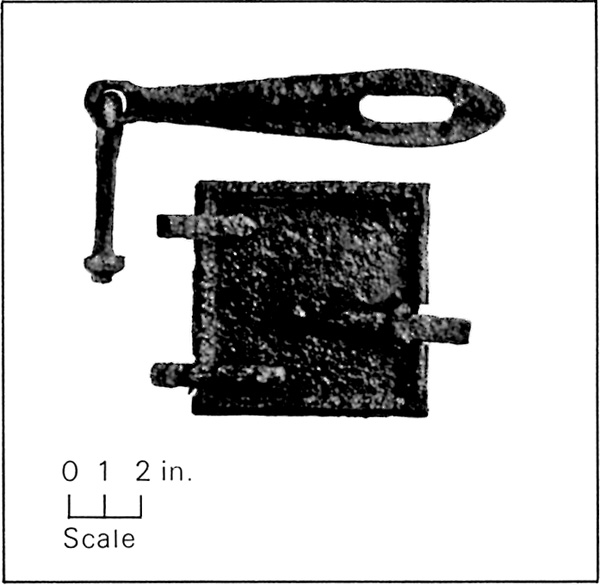
63 A hasp used on one of the interior doors and a small vent door used
in the barracks stores.
|
The hinges used to swing the closures in the structure were either
cast iron, wrought iron or brass. The brass hinges (Fig. 64) were used
on the doors and windows of the magazine. The wrought iron hinges varied
in size from 2 ft. to 3 ft. strap hinges used to hang the larger doors
to the smaller T-shaped hinges used to hang the interior shutters on the
second level windows. Very large pintles such as the type shown in
Figure 58 were used for the major doors.

64 Copper window hinge from powder magazine window. View is from the
north.
|
The above-mentioned types of building hardware constituted the bulk
of that found within the building, although there were several
miscellaneous items found. These included an iron ring, several iron and
copper floor grates, lock parts, two sliding bolts and a very corroded
thumb latch. Thumb latch fixtures were used on the doors of the third
level privies as seen in Figure 65, and were probably used on the other
doors in the structure.
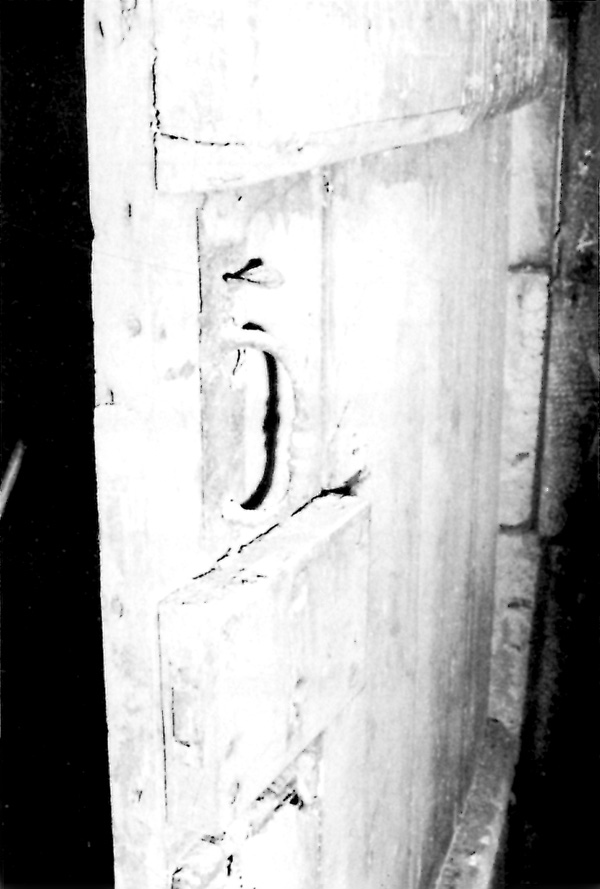
65 Thumb latch, door lock and sliding bolt used to secure the latrine
door of latrine B.
|
Ordnance
In the original proposal the Market Shoal tower was designed to carry
two 32-pounder smoothbore cannon and one 24-pounder smoothbore cannon on
the gun platform and three 32-pounder carronades on the second level.
This plan was changed and the tower was ultimately armed with three
32-pounder smoothbore cannon on dwarf traversing carriages on the gun
platform. Although the carriages were stamped 1857, this was not the
date that the tower was armed but the date that the carriages were
manufactured. They were shipped out to Kingston in 1859 and the first
two guns were mounted in 1862. The third was installed in 1863. These
three guns still remain on their carriages as installed. The first two
carronades which fired from the second level windows were installed in
1862 and the final carronade was installed in 1869. The mounting of all
these guns was prompted by the Civil War in the United States. The
inventory of excavated ordnance was relatively small, consisting of
three 32-pound solid shot, 114 small-shot, 14 grape-shot platforms and
six iron discs. There was no smallarms equipment found except for one
trigger guard (Fig. 69).
The three cast-iron solid shot weighed 31 lb. 7 oz. each. The
grape-shot was also cast iron and weighed 2 lb. 12 oz. each and had a
uniform diameter of 2-3/4 in. All of these smaller shot were found in
the No. 1 ordnance store as were their spindles and bases. These shot
still had fragments of canvas clinging to them and the platforms upon
which the shot were stacked consisted of iron discs 7/16 in. thick with
a diameter of 6 in. (Fig. 66). The spindles, forge welded to their
centres, had a height of 8 in. and the shot was stacked upon these bases
three high in rows of three, then wrapped in canvas and bound in place
with rope. This type of shot was known as quilted grape-shot and nine of
them plus the spindled iron disc weighed 30 lb. (See Gooding
1965: 41). The iron discs were also probably used to make a type of
grape-shot. This type, described by Manucy (1949: 69), consisted of iron
shot set in tiers in a canvas sleeve and separated by iron discs. These
discs were 7/16 in. thick and had a diameter of 5 in. There were also
some fragments of tin sheeting found in close proximity to these shot
which may indicate that tin cannisters were also used to encase the
shot. This sheeting was too fragmented to determine its use with
certainty, however.
Ordnance Hardware
The hardware associated with the working of the guns was also
sparsely represented, consisting of three cleats and one iron skid (Fig.
66) for a gun carriage.
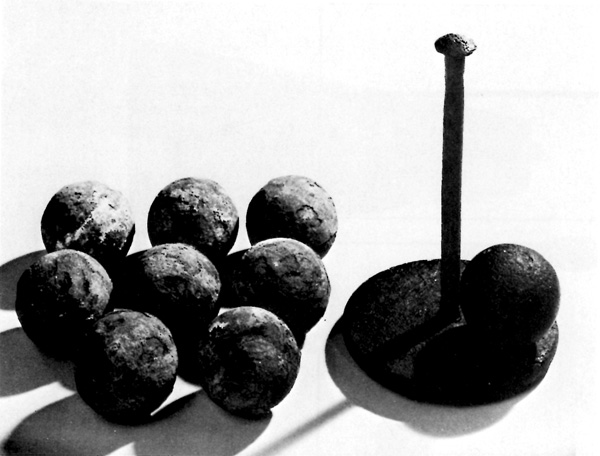
66 Spindle, plate and shot from the No. 1 ordnance store. This shot was
used to make quilted grape shot. Remnants of canvas can still be seen
clinging to the shot.
|
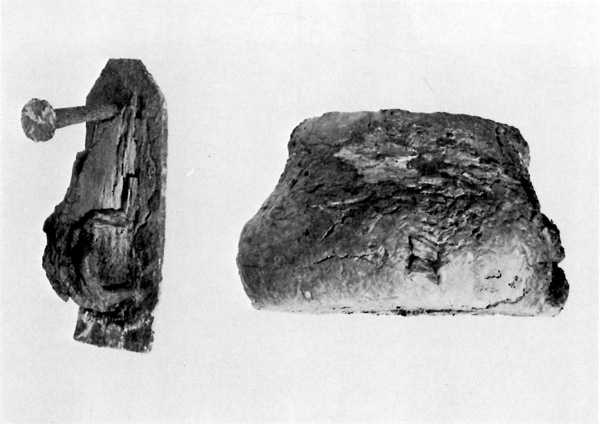
67 Gun carriage skid and wooden capstan for gun carriage or a tampon for
the mouth of a cannon.
|
Artillery Tools
One gunner's pick was found and it is illustrated in Figure 68. A
ratchet lever or crank (Fig. 70) for elevating a 32-pounder cannon was
also found.
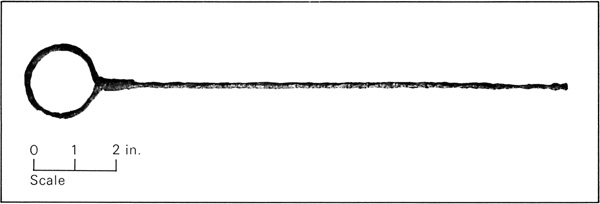
68 Gunner's pick. This tool was used by the gunner to clear the vent
hole and puncture the powder keg.
|
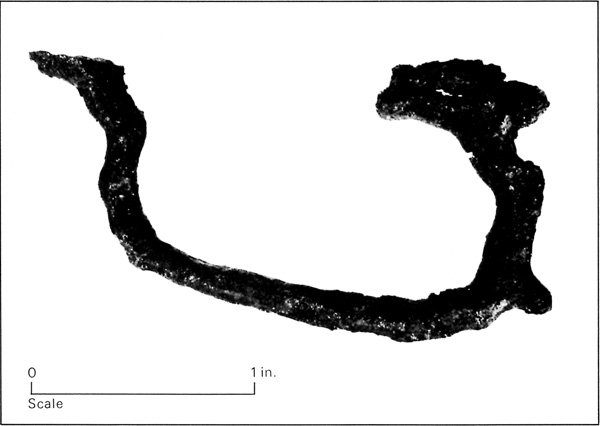
69 Trigger guard from some type of smallarm.
|
Miscellaneous Metal Artifacts
This category consisted of a mason's chisel a pulley wheel and some
stove parts. Also included in this inventory was an 8-oz. nesting weight
(Fig. 72) for an equal arm balance with the inscription "Canada" on the
back. Below this was a crown over the letters "VR" over an "A". Two
lateen spoons were also recovered, as well as one padlock and lock
escutcheon (Figs. 73 and 74). Some cast ornamental iron grill work (Fig.
75) was found, but not enough to determine the pattern employed.
Wooden Artifacts
The wooden artifacts consisted mostly of door and window framing and
moulding. The objects included in this collection do not represent any
sort of statistical sample of the material available for much of it was
left in place for future study. Samples of the mouldings, floor joists
and flooring were brought back to Ottawa for analysis toward species
identification. It is currently believed that most of the wood used in
the construction of the tower was oak. The other wooden objects were a
quoin (Fig. 70) used for elevating a 32-pounder cannon or carronade and
a wooden capstan for a 32-pounder gun carriage (Fig. 67). Stamped on the
end of the quoin was the inscription "32PR WD." (Fig. 71)
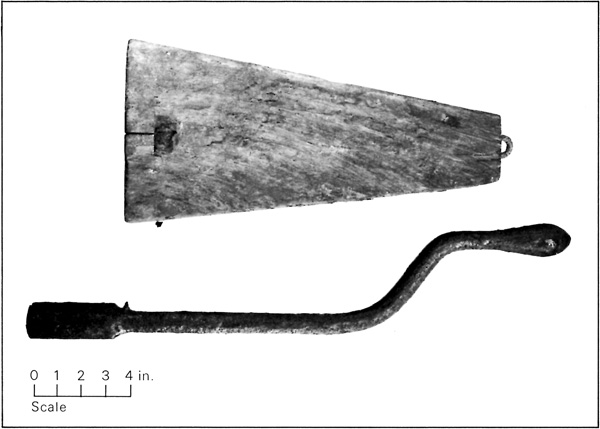
70 Wooden quoin or wedge and wrought-iron crank used for elevating a
32-pounder cannon or carronade.
|
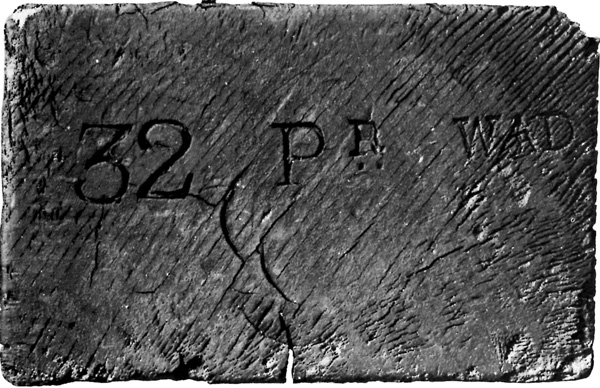
71 Base of wooden quoin with the stamped inscription "32 PRW
[broad arrow] D." The broad arrow is the mark of the British Board of
Ordnance.
|
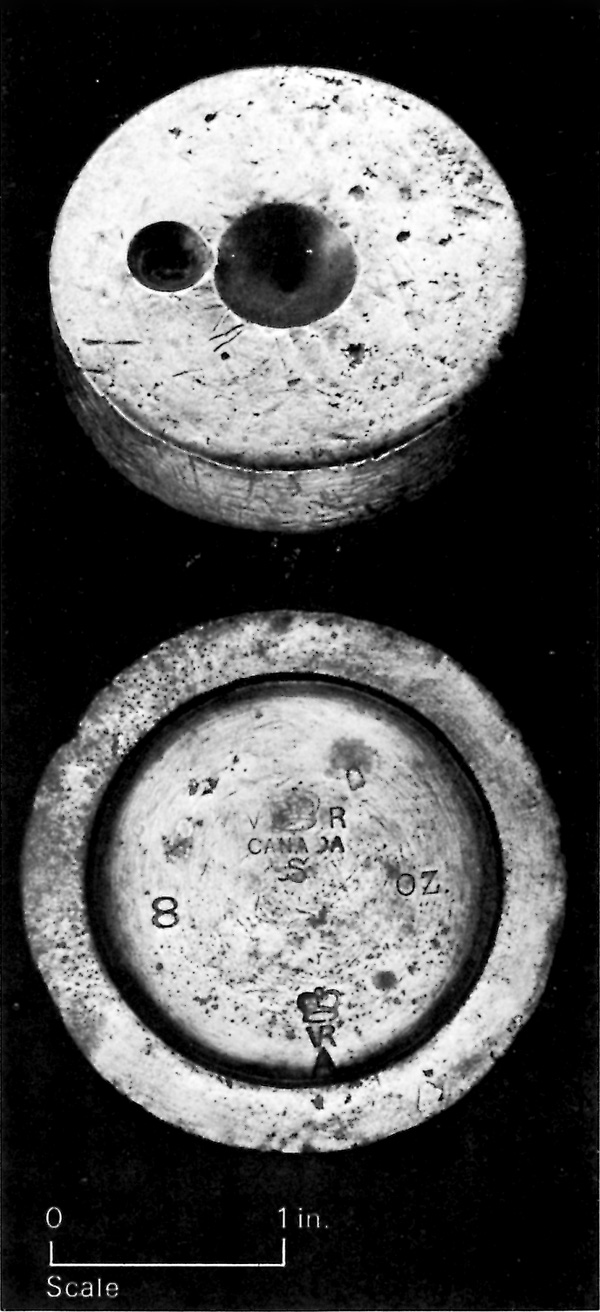
72 Obverse and reverse sides of an 8-oz. brass scale weight.
|

73 Brass lock escutcheon from the commissariat store.
|

74 Iron padlock with brass escutcheon plate.
|
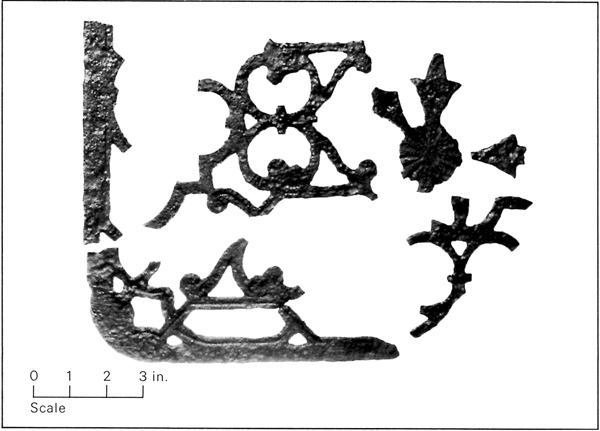
75 Fragments of cast iron grillwork. Not enough of this grill was found
to determine the complete pattern and its use is not known.
|
Uniform Racks
Aside from the flooring and window moulding the other major use of
wood in the tower was in the construction of uniform racks that lined
the walls of all the rooms. These racks were held in place by the wall
anchors described under metal artifacts, accounting for such a large
number of those items. The racks consisted of planks attached to the
walls into which were inserted spindles of the type shown in Figure 76.
Most of these spindles had rotted at their bases and had collapsed into
the debris that filled the tower. All of this woodwork was painted
grey.
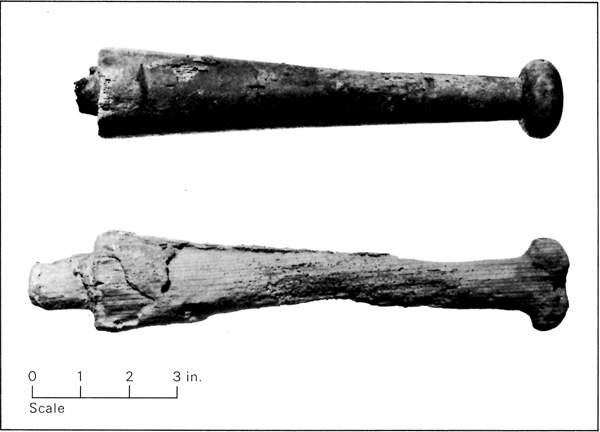
76 Wooden uniform or equipment hangers. Although the provenience for
these particular specimens is unknown, it is certain they were used in
all rooms of the tower including the magazine.
|
Miscellaneous Wooden Artifacts
Miscellaneous artifacts included one black checker game piece and
several pieces of wooden dowel used as uniform hangers or racks.
Bone Artifacts
There were only three bone-handled utensils found in the excavation,
a three-pronged fork, a knife and a toothbrush handle (Fig. 77). This
toothbrush handle was marked "N. C. POISON — Kingston." There was
also a small bone gaming die found (Fig. 78). The rest of the bone
consisted of food bones with butcher marks and some skeletal material
from small animals that must have gotten into the tower and died there.
No analysis has yet been done of this material.
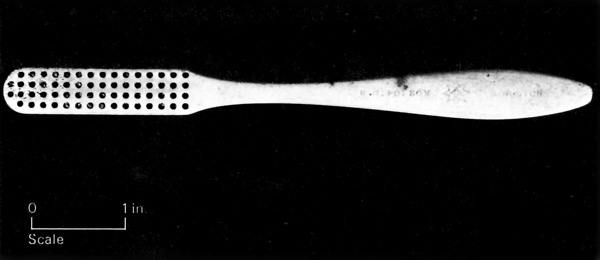
77 Bone toothbrush handle with "N. C. POISON — Kingston" stamped in
the handle.
|
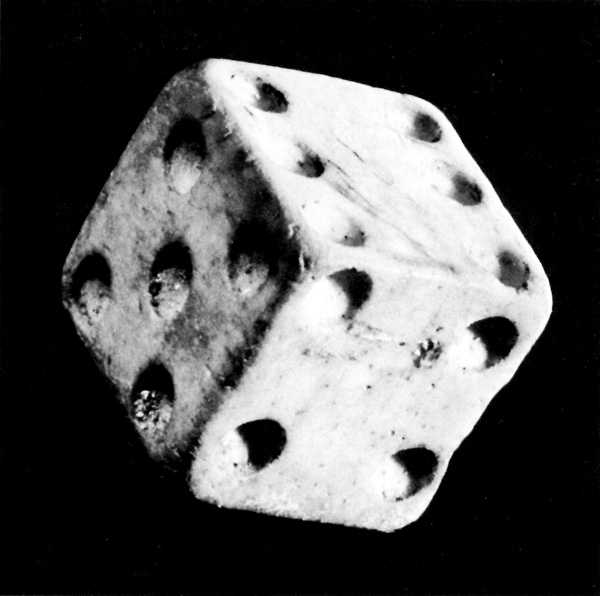
78 Bone gamming die.
|
Leather Artifacts
Shoes
Leather shoes were found in the No. 2 ordnance store and in the
area of the commissariat store. Only one shoe was found in this latter
area, but the total possible number of shoes found was five. This figure
is based on the differing types of shoe parts found.
Vamps
There were three vamps found in the No. 2 ordnance store and all
three had been joined to the lower parts of the shoe by use of the
MacKay process of stitching patented in 1862 (Anderson 1968: 59). One of
these vamps actually had the vamp and quarters combined into one piece
joined at the heel, and the quarters were eyed for laces (Fig. 79). The
shape of all three vamps was that of a rounded toe.
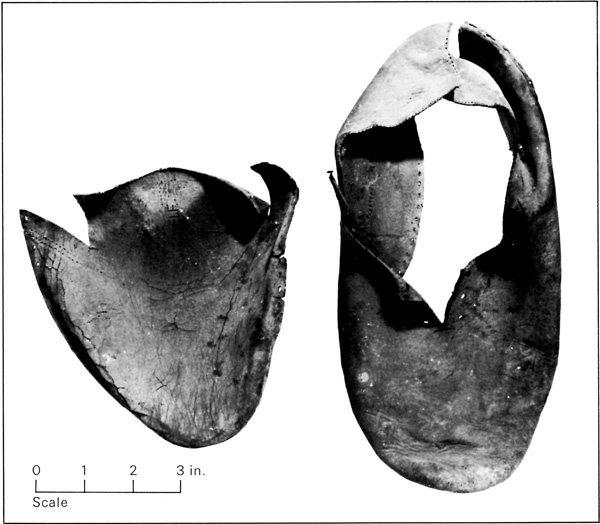
79 Shoe vamps from the No. 2 ordnance store. The vamp on the left has
the letters "I. F." stamped in the leather.
|
Quarters
There was only one quarter found and this had been attached to the
sole by stitching and had been eyed for laces. This quarter probably
belonged to one of the vamps mentioned above.
Outsoles
There were two blunt-toes outsoles (Fig. 80) found in this room
as well, but manufacturing processes indicate that they were not a
pair. One of these outsoles had been fastened to the uppers by the
MacKay process mentioned above with the aid of a screw machine, and the
other outsole exhibited the Goodyear Welt process which was patented in
1875 (Anderson 1968: 61). The other outsoles found in this room and
belonging to a pair were also manufactured with the Goodyear Welt
process. In this case the soles had been turned before the uppers were
sewn in place and the heels were attached with wooden pegs. These two
shoes postdate 1875. There were also two insoles and one heel lift from
this area and they dated from the same period and probably belonged to
the same shoes. The only other significant shoes parts found were in the
commissariat stores. These parts were all fragments of one shoe and
included the vamp and outsole. The entire shoe was held together with
wooden pegs indicating an earlier date than those shoes mentioned above.
After 1846, when Elias Howe Jr. patented a sewing machine designed to
attach the uppers to the lowers by stitching, the peg method of
fastening the uppers to the lowers was rapidly supplanted; thus this
shoe was probably manufactured shortly after that date. This may have
been the oldest shoe found in the excavation.
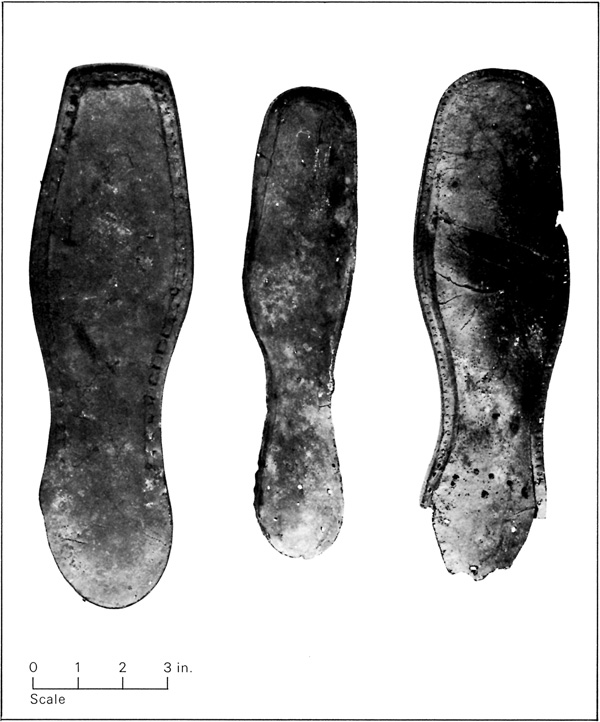
80 Shoe-soles from the No. 2 ordnance store. The top two outsoles were
attached ts the uppers of vamps by the Goodyear Welt process and the
bottom outsole was fastened by the MacKay process. Symbols used in
drawings.
|
As a final statement to this section on artifacts, it would appear
that most of the material found within the tower was deposited there
during the last part of the 19th century. Most of this material dated
from 1860 to 1890 with a few artifacts both earlier and later. This
arrangement would be expected, given the active life span of the tower
and the personnel concentration which was at its highest during the
l860s. The structural artifacts can be dated with some sort of surety to
the early period of the tower, that is, 1847-49, with the exception of
the ordinance which was installed in the 1860s. The major importance of
these artifacts lies in the information they can convey concerning the
structure itself and its periods of activity rather than in presenting a
representation of the quality of life of the persons that occupied the
tower.
|

